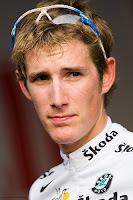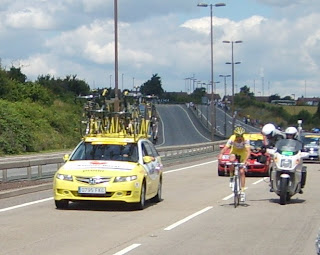The Tour is starting in just a couple days! Let's continue getting prepared by running down the list of potential contenders for the Tour's top prizes. Today we'll introduce the yellow and green jersey contenders.
*****
General Classification - Yellow Jersey
It's one of those Tours where one man is heavily favored to win the yellow jersey. The rest of the field, especially those on stronger teams, may try to use cunning tactics to try to steal the top spot. Other top riders might merely aim for a Top 3 finish for a spot on the revered podium in Paris.
Alberto Contador (Astana)
The winner of the 2007 and 2009 Tours de France would have been a favorite to win the 2008 Tour had his team been eligible to race, and is a heavy favorite to win this year's edition. Contador's climbing skills are beyond compare, and his time-trialling has developed to an elite level. His team won't be the strongest, and Contador has been battling the flu lately, but he is still the man to beat.
Andy Schleck (Team Saxo Bank)
Last year's runner-up and two-time white jersey winner will look to improve his standing this year. His mediocre time trial skills will be helped by the presence of only one long time trial in this year's course. He may by now have the ability to keep up with Contador, but must be more aggressive than that to emerge victorious. Fortunately, he has a solid team and a nearly-as-dangerous teammate in his older brother Frank, and can perhaps devise some tactics to shake off the champion.
Lance Armstrong (Team RadioShack)
After an impressive podium finish in last year's Tour during a sudden comeback, Lance will now have a longer period of training behind his back and should be more prepared for this year's Tour. At the age of 38, his climbing skills and especially time-trialling skills have unsurprisingly not been at the level of his glory days. However, his recent second place finish at this year's Tour de Suisse may be an indicator that he's in good shape. He'll also have an incredibly deep team to help him out, or to take over should he fall behind.
Ivan Basso (Liquigas-Doimo)
The winner of the Giro d'Italia in 2006 and 2010 is aiming high this year by riding in both the Giro and the Tour. Not many cyclists dare ride two Grand Tours back-to-back, and the last person to win both the Giro and the Tour was fellow Italian Marco Pantani back in 1998. While the victory in this year's Giro showed that Basso is still among cycling's elite, whether he will have enough left in the tank for the Tour is still a mystery.
Cadel Evans (BMC Racing Team)
Year after year, Cadel Evans has finished close to the top, but has never won the Tour. His participation in the year's Giro may be an indication that he may not be aiming so high this year, with Contador being so dominant. Evans is an outstanding time-triallist, but has a reputation for riding extremely passively on the mountains. He can no longer rely on his time trial abilities on this year's course, which only has one stage of the kind.
Denis Menchov (Rabobank)
Menchov has had a similar history to Cadel Evans, always coming close to the win but falling short. He has won the Giro d'Italia and twice won the Vuelta a España, but hasn't gotten the same results on the Tour. With the competition getting stronger, and with his team dividing their attention between him and sprinter Oscar Freire, it could be a tough road ahead for the Russian.
Bradley Wiggins (Team Sky)
The track-cycling phenom surprised everyone last year by showing that he could climb with the best, leading to a 4th place finish on the Tour. This year, Wiggins will look to remove any doubt that last year's result was a fluke. His new team is relatively weak, but the time trial is as flat as a velodrome and should feel familiar to the Briton, who may be a wild card this year for a podium finish.
Others to watch
Frank Schleck (Team Saxo Bank)
Andreas Kloden (Team RadioShack)
Levi Leipheimer (Team RadioShack)
Robert Gesink (Rabobank)
Samuel Sanchez (Euskaltel-Euskadi)
Jani Brajkovic (Team RadioShack)
Alexandre Vinokourov (Astana)
Roman Kreuziger (Liquigas-Doimo)
Carlos Sastre (Cervélo TestTeam)
Christian Vande Velde (Garmin-Transitions)
Tony Martin (Team HTC-Columbia)
*****
Points Classification - Green Jersey
Last year, Mark Cavendish made a statement by establishing himself as the dominant pure sprinter on Tour. However, it was Thor Hushovd who quietly won the green jersey by winning points on stages that weren't prototypically set up for bunch sprints. This year, the question will largely be the same, with the contenders being a mix of pure sprinters, who go blazing fast on the flats but get dropped by the peloton on the climbs, and what I call "hybrid sprinters," who can consistently place high on bunch sprints but can also keep with the peloton on climbs.
Mark Cavendish (Team HTC-Columbia)
The young Briton's meteoric rise culminated in an incredible six stage wins in last year's Tour de France. While Cavendish's main target was stage wins, he may have won the green jersey had it not have been for eventual winner Thor Hushovd's ability to grab points on steeper stages. Cavendish's performance this year has not been as dominant as last year, but he remains a favorite to win most of the flat stages on Tour, and one of the top contenders for the green jersey.
Thor Hushovd (Cervélo TestTeam)
The recipient of last year's green jersey won the prize through consistency - staying with the pack on flat stages with climbs near the end, and riding aggressively on intermediate levels. While he wasn't the fastest pure sprinter, he placed high on every sprint and grabbed points on the most stages. If he wants to win the green jersey this year, he will have to follow a similar approach, as we can expect Cavendish, if in top shape, to win just about every traditional sprint finish.
Oscar Freire (Rabobank)
The winner of the green jersey in 2008 has a similar riding style to Thor Hushovd. The Spaniard has the ability to stay with the pack on lesser climbs, and even to hold his own in a breakaway. He is also notoriously adept at sprints with a slight uphill incline. Freire will have to try to take advantage of these particular sprints, and will have to ride just as aggressively as Hushovd to have a shot at green.
Tyler Farrar (Garmin-Transitions)
The young American has been fast-rising in the sprinting ranks, but at this point is a kind of poor man's Cavendish. Farrar is a pure sprinter who may be able to get a very high standing in most traditional sprint stages and may win a stage or two. However, he will have an extremely difficult time outscoring Cavendish on a consistent basis, and his only shot at the green jersey would realistically happen if Cavendish gives up in the mountains.
Others to watch
Edvald Boasson Hagen (Team Sky)
Robbie McEwen (Team Katusha)
Gerald Ciolek (Team Milram)
Jose Joaquin Rojas (Caisse d'Epargne)
*****
Tomorrow, we'll wrap up the Tour preview with a rundown of the contenders for the polka-dot jersey, white jersey, and team classification.















































